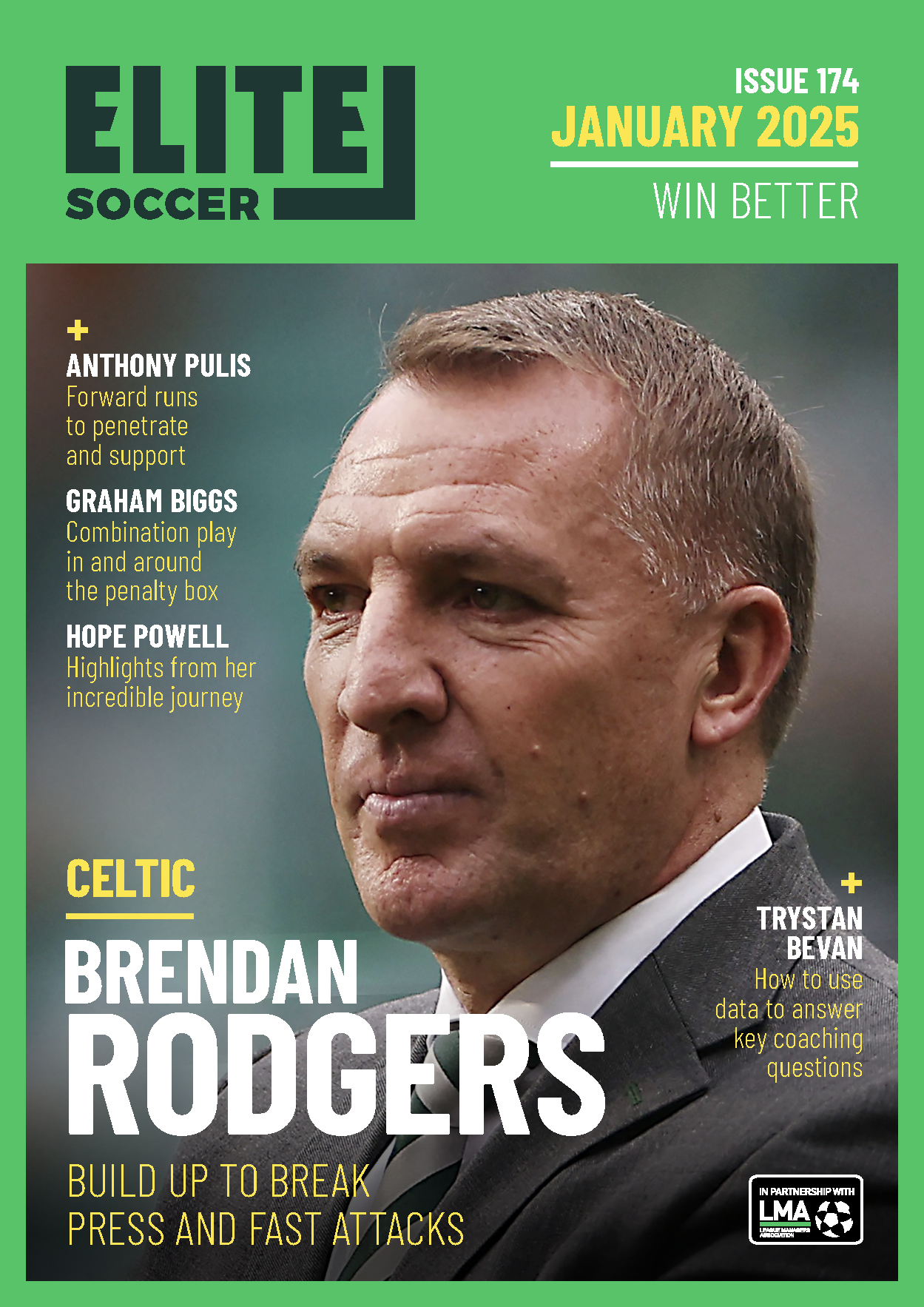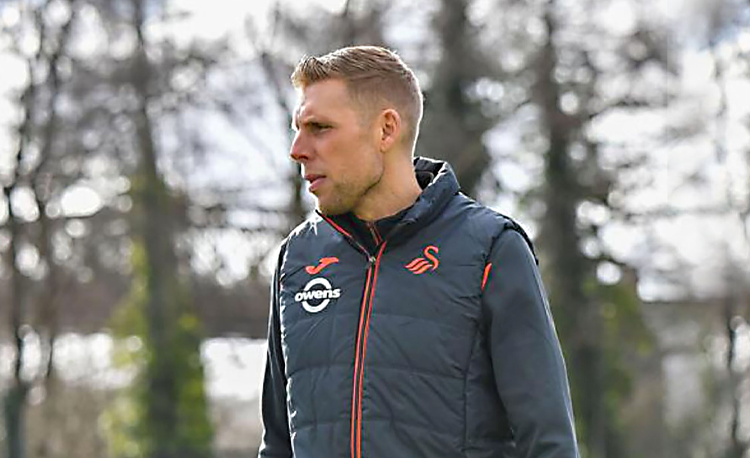You are viewing 1 of your 1 free articles
Attacking patterns of play
Use this session to reinforce offensive movements and to highlight the importance of good technical passing and receiving, crossing and shooting.
| Area | 2/3rds of a pitch |
| Equipment | Balls, cones (or mannequins), goal |
| No. of Players | 15 plus keepers |
| Session Time | Diagonal passes 20mins, Progressions 15mins, Game situation 20mins |
This session is about an attacking shape of play, and how it can be used in two ways – firstly, to reinforce offensive movements, but beyond that to highlight the importance of good technical passing and receiving, crossing and shooting.
We are always looking to replicate specific match movements in training whilst presenting the players with decision-making situations that best prepare them for forthcoming fixtures.
What do I get the players to do?
Diagonal passes
We begin by setting up as shown (1a). The ball is fed in from each side of the halfway line into a central player, and a diagonal is pass then played forward. The lines of pass are very specific with right-back and left-back positions the starting points. The four centre-forwards stay as strikers, while all other players pass and follow.
1a
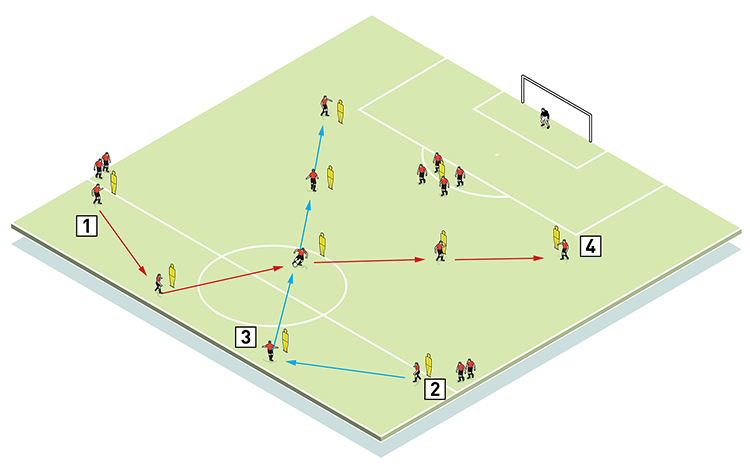
2. The ball is fed in from left and right sides
3. A diagonal pass is made into the midfielder
4. The ball is passed on to wide players who pull off their mannequins to receive
When the pass has been made into the left or right wide man, a cross is made where attackers challenge near and far post (1b).
1b
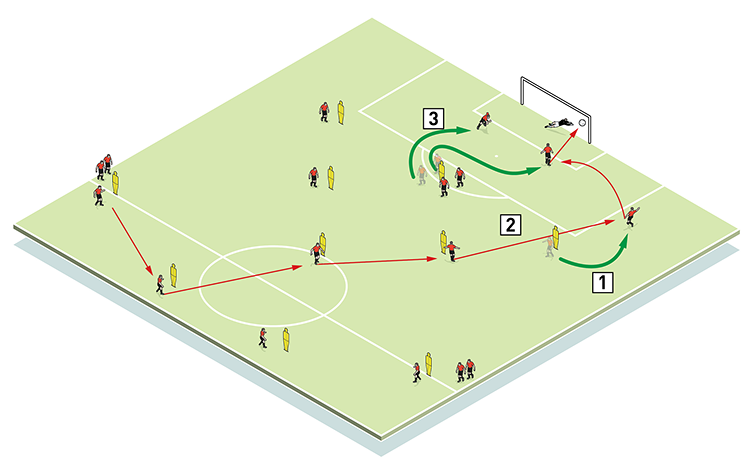
2. A variation sees the final pass played inside the mannequin
3. Two of the centre-forwards peel off and make for near- and far-post areas
As soon as the cross is made we will repeat the move from the opposite start point – it’s essential to maintain a good tempo in ensuring players aren’t standing still for long periods.
How do I progress the session?
The first progression sees a series of one-twos as the ball makes its way forward (2). The emphasis here is on good movement, passing and communication.
2
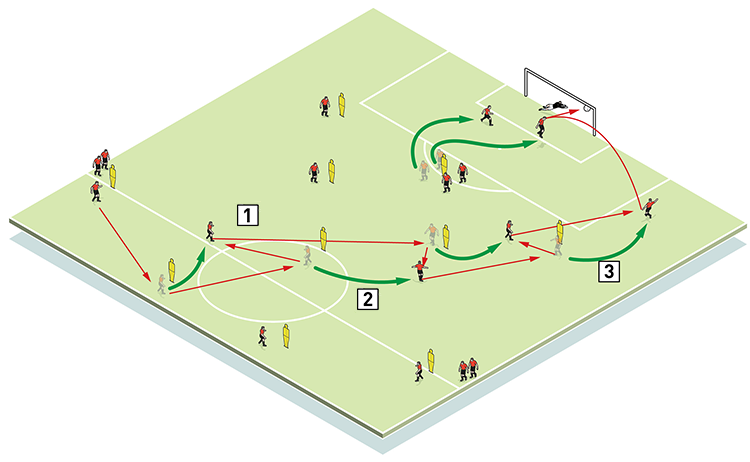
2. Each man follows his pass in moving into the next space
3. Again players pull off their mannequins to receive
In the next progression we are again looking for more intricate interplay, so that attacks are fast, purposeful and unpredictable. Here we are creating zigzag lines as players from left and right attacking diagonals step in on each others’ attacking moves, with previously non-working centre-forwards now helping to move the ball wide to the flank before a cross into the middle (3).
3
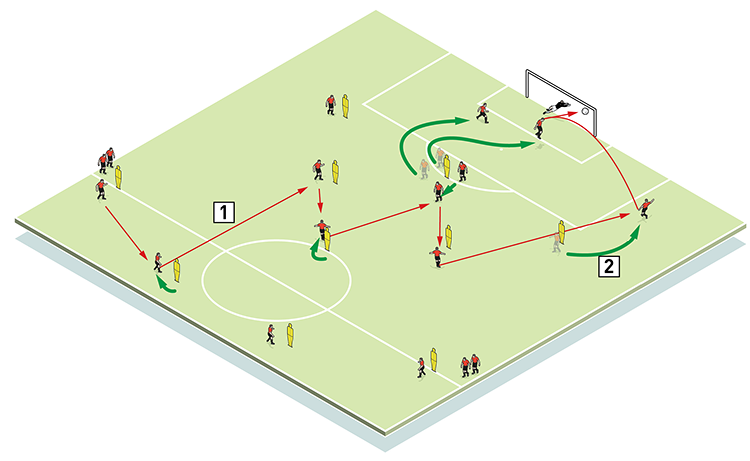
2. Again a cross produces the required finish
Moving on again, we will introduce crossover runs by attacking midfielders (4). We can also encourage players to go long, cut inside or shoot from distance.
4

2. The progression sees midfielders crossing over
3. It combines long passing into feet with short balls dropped off for team mates to work with
4. Attackers also perform crossover runs in making their way into scoring
There are a variety of further progressions – from overlapping full-backs, the addition of defenders in the box or even rotation of midfield positions.
What are the key things to look out for?
We are looking for timing of movement, weight and accuracy of the pass, positive decision-making and good angles of runs into the box, all the time looking to ensure a positive end product.
How do I put this into a game situation?
We can now move this into a full-size 11v11, or play box-to-box if the squad is smaller. Whatever pitch size we use, we must allow for the implementation of the key patterns and movements as outlined.
Related Files
Editor's Picks
Using the goalkeeper in build-up play
Pressing principles
Intensive boxes drill with goals
Penetrating the final third
Creating and finishing
My philosophy
Pressing initiation
Compact team movement
Defensive organisation
Coaches' Testimonials

Alan Pardew

Arsène Wenger

Brendan Rodgers

Carlos Carvalhal

José Mourinho

Jürgen Klopp

Pep Guardiola

Roy Hodgson

Sir Alex Ferguson

Steven Gerrard
Coaches' Testimonials

Gerald Kearney, Downtown Las Vegas Soccer Club

Paul Butler, Florida, USA

Rick Shields, Springboro, USA

Tony Green, Pierrefonds Titans, Quebec, Canada
Join the world's leading coaches and managers and discover for yourself one of the best kept secrets in coaching. No other training tool on the planet is written or read by the calibre of names you’ll find in Elite Soccer.
In a recent survey 92% of subscribers said Elite Soccer makes them more confident, 89% said it makes them a more effective coach and 91% said it makes them more inspired.
Get Monthly Inspiration
All the latest techniques and approaches
Since 2010 Elite Soccer has given subscribers exclusive insight into the training ground practices of the world’s best coaches. Published in partnership with the League Managers Association we have unparalleled access to the leading lights in the English leagues, as well as a host of international managers.
Elite Soccer exclusively features sessions written by the coaches themselves. There are no observed sessions and no sessions “in the style of”, just first-hand advice delivered direct to you from the coach.



